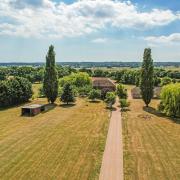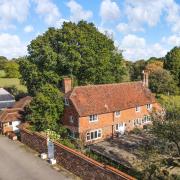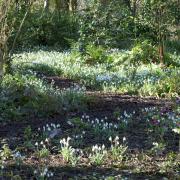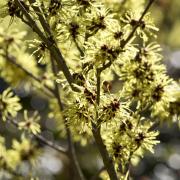The environmental benefits of keeping a little space wild within your garden are well known, but how to ensure the area flourishes?
Fancy creating a dreamy meadow this year, wafting with colour and alive with bees and butterflies? Now is a great time to begin the process. Wildflower meadows are one of the richest habitats for wildlife, due to the greater diversity of plant species they contain. In a long-established meadow you can find as many as thirty different species in a square metre, and even higher numbers on chalkland. The traditional meadowland is not a natural environment, though, having originated from the farming practice of grazing animals and making hay. As the top layer of growth was continuously removed, woody species couldn’t become established, lowering the fertility levels of the soil. This allowed grasses to become less dominant, enabling wildflowers to flourish. Over the past hundred years, wildflower meadowland, one of the rarest habitats in the UK, has declined due to more intensive cropping and the spread of settlement.


Our friends at the Wildlife Trusts, including KWT, put a huge amount of effort into managing these rare habitats and they play a major role as a vital food source for declining bees, butterflies and beneficial insects: seed heads, for instance, are nature’s bird feeders and stems are ideal for hibernating ladybirds. What could be prettier than bringing this tapestry of life into your own garden, whether it’s a large swathe as a mini-meadow, confined in parterre beds or even in a container? There are many websites to inform your choices and some wonderful gardens to visit locally that will inspire ideas for the range of possibilities you can try.
Keep in mind that you need an area that has direct sunlight most of the day. Meadows work well against a backdrop of shrubs or hedges and at the end of the garden. Mown paths through tall summer meadows give definition and a sense of intent. To create a meadow takes more than just letting a rough section of grass grow wild. You need to tailor the planting to your conditions. It takes planning, commitment and patience, but is well worth it. Some must-have flowers include ephemeral and free spirited poppies, with their dazzling tissue-paper skirts dancing in the breeze, bright blue tufty cornflowers, and prolific scabious, which keep on giving over a long season. Now is a great time to locate the site, select appropriate seeds and prepare the area ready to sow in March or April for a summer meadow.


There are some wonderful meadow seed mixes available for different soil types to create spring or summer meadows, with blends for dry, heavy, chalky, moist or acidic soils in sunny, woodland, waterside and hedgerow habitats. Annual and perennial mixes, using blends of native and non-native hardy plants, and are readily on offer through a range of companies, including ones with specific Kent mixes to suit our soils and conditions. We are fortunate, too, to have selections available from a local company, Kent Wildflower Seeds, a recently launched offshoot of T. Denne and Sons, originally founded in 1879 and the largest processors of grass seed in the country. Over the past four years fifth generation Fred Denne and his wife Charlotte have been establishing a commercial wildflower seed business. Native seed is harvested from a range of landowners’ fields through their contacts - across the county from the Wye Valley to Dover - with different soils and habitats. The seed is then separated, cleaned and sorted to make up the mixtures on offer, including one for heavy Wealden clay, a low-growing garden selection and a North Downs perennial mix. ‘From selling in bulk, we are now also selling smaller amounts retail, at plant fairs and online, so people can create large meadows or just have planters on the patio,’ explains Charlotte.
I would advise starting with an annual mix; experiment with the look you are after before graduating to sowing one of the perennial mixes. Grasses and wildflower mixes take longer to establish; will start to look good in the second year and improve from then on. Select a cornfield annual mix for a display the first summer, with a show of poppies, cornflowers and marigolds. For something a bit more instant, if your budget allows, you may like to use pre-sown wildflower turf, selecting one with a high proportion of flowers. Once established, meadows are quite low maintenance, though plants need cutting down after flowering, with cuttings removed so these don’t increase fertility. A trick to help stop grasses overtaking the flowers is to add in some yellow rattle in late summer or autumn - essentially, it pinches nutrients from the grass, making it less fertile and giving other plants a better chance of thriving. Meadows can be a glorious addition to the garden, whether purely of wildflowers or enhanced with other species. They produce a harmonious medley of colours and varieties, attractive both to us and to a host of wildlife.


To know
• Kent Wildflower Seeds, Wye Valley
kentwildflowerseeds.co.uk
Private gardens to visit

Goddards Green, Cranbrook
Meadow area with mown paths and seating
Doddington Place, ME9 0BB
Areas of naturalised and meadows
doddingtonplacegardens.co.uk

Pheasant Barn, Oare
Colourful meadow with sculptural focal point
Falconhurst, Markbeech
Drifts of meadows with pathway
Chevening, Sevenoaks
Wildflowers by the house, around the lake and in the Pitt Garden designed by Marian Boswall
See NGS website for the opening times
ngs.org.uk
Helpful websites
• British Trust for Conservation btcv.org.uk
• Landlife Wildflowers wildflower.org.uk
• British Wild Flower Plants wildflowers.co.uk
GET THE LOOK
The first step is to assess your soil’s fertility. Wildflowers grow best on poor, dry soil, as fertile soils allow grasses to overtake the less vigorous flowers. Perennial weeds such as dock, dandelions and thistles indicate fertile soils, and these will need to be removed before sowing. Dig or rotavate the soil, turning over the richer topsoil and burying it beneath poorer subsoil. Firm down the soil, rake it level and leave for a few weeks to remove any germinating weeds. Annual meadows will need some repeated sowings; others will improve over time,with many plants self-seeding to reinforce the natural effect.
Top tips from Charlotte Denne, Kent Wildflower Seeds

• For optimum results, sow when the ground temperature is above 12 degrees [mix with silver sand to make it easier to broadcast evenly]
• You need warmth, sunlight and moisture - sow in March or April for a summer meadow
• I’d recommend starting with our Pollinator Wildflower Mixture for bees and butterflies, as it has annuals and perennials and will suit a mix of soil types
• Don’t scatter seeds on grass as the grass will out-compete the seeds
• If looking to establish in grass manage first with yellow rattle to push back the grass
• Sow on bare soil, in pots or borders - you don’t want enriched soil
• Remember that the seeds germinate on the surface of the soil so don't push them in too deeply - just use your hands or walk on them
• Collect seed from the annuals that have established well in September to re-sow
• When you cut back the meadow the plants can lie on the soil for a couple of weeks to drop seed, ideally during periods of rain, but then clear all away so not to add nitrogen to the soil.




























